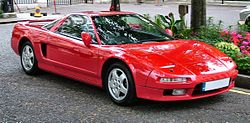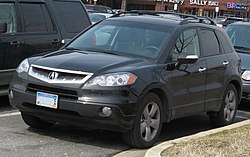 Acura (Akyura) is a luxury brand of Japanese automaker Honda Motor Company. It has been used in the US, Canada and Hong Kong since March 1986 to market Honda's luxury automobiles and near-luxury vehicles. The brand was introduced to Mexico in 2004 and to the Chinese market in 2006. It is also planned to extend Acura to the Japanese domestic market two years from 2008 or so. With the Acura brand, Honda is credited with being the first to tap into a market for luxury Japanese cars outside Japan. Before Acura, automobiles exported from Japan were primarily economical in design and largely targeted at low-cost consumers.
Acura (Akyura) is a luxury brand of Japanese automaker Honda Motor Company. It has been used in the US, Canada and Hong Kong since March 1986 to market Honda's luxury automobiles and near-luxury vehicles. The brand was introduced to Mexico in 2004 and to the Chinese market in 2006. It is also planned to extend Acura to the Japanese domestic market two years from 2008 or so. With the Acura brand, Honda is credited with being the first to tap into a market for luxury Japanese cars outside Japan. Before Acura, automobiles exported from Japan were primarily economical in design and largely targeted at low-cost consumers.
In 1986, following a decade of research and development, the Honda Motor Company opened 18 all-new dealerships in North America to support its Acura automobile division. Acura was the first Japanese luxury brand to appear, and its initial offerings consisted of four models: the Legend, a V6-powered coupe and sedan, and the Integra, available as a five-door and three-door hatchback, as well as a sedan. The success of these models led to competing Japanese luxury brand ventures (Toyota's Lexus and Nissan's Infiniti).
In 1990, four years after the debut of the Legend and Integra, Acura introduced the NSX, a midship V6 powered, rear-wheel-drive sports car. The NSX, an acronym for "New Sports eXperimental", was billed as the first Japanese car capable of competing with Ferrari and Porsche. This vehicle served as a halo car for the Acura brand. The NSX was the world's first all-aluminum production car.
 Despite a strong start for the Acura brand (in terms of market acceptance), sales suffered in the mid- to late 1990s. Some critics attributed this decline in part to less inspiring designs. Additionally, during this time Acura switched to an alphanumeric nomenclature formula, dropping the Legend and Integra titles. The 1996 3.5 RL, which replaced the popular Legend, was seen by many as the epitome of this problem, namely because the RL designation was more anonymous than the former Legend title. Also, the RL's 210-horsepower V6 (later increased to 225 hp) and front-wheel drive, together with a high price and styling that cautiously copied the larger and more powerful Lexus LS 400, did little against BMW, Audi, and Lexus, and other competitors. During this time, the NSX also lost sales as Acura made few changes from its original 1989 trim. A year later, the Integra sedan was withdrawn, replaced by the Acura 1.6EL, which was only sold in Canada as a rebadged Honda Civic. The Integra sedan continued to be sold in the United States until 2001.
Despite a strong start for the Acura brand (in terms of market acceptance), sales suffered in the mid- to late 1990s. Some critics attributed this decline in part to less inspiring designs. Additionally, during this time Acura switched to an alphanumeric nomenclature formula, dropping the Legend and Integra titles. The 1996 3.5 RL, which replaced the popular Legend, was seen by many as the epitome of this problem, namely because the RL designation was more anonymous than the former Legend title. Also, the RL's 210-horsepower V6 (later increased to 225 hp) and front-wheel drive, together with a high price and styling that cautiously copied the larger and more powerful Lexus LS 400, did little against BMW, Audi, and Lexus, and other competitors. During this time, the NSX also lost sales as Acura made few changes from its original 1989 trim. A year later, the Integra sedan was withdrawn, replaced by the Acura 1.6EL, which was only sold in Canada as a rebadged Honda Civic. The Integra sedan continued to be sold in the United States until 2001.
Despite these letdowns, Acura gained prominence in the 1990s with a young group of customers: tuner enthusiasts. Parent company Honda's reputation with this demographic as a maker of "easy-to-tune" and "rev-happy" engines rubbed off onto Acura, and the Integra became a popular tuner car.
Beginning around the year 2000, Acura experienced a rebirth which was catalyzed by the introduction of several redesigned models. The first of these models was the 1999 Acura 3.2 TL, an upscale sedan competing with the likes of the Lexus ES, Infiniti I30, and BMW 3-series. Critics suggested that although 3.2 TL did not outdo its competition in any one area, it offered a well-rounded blend of sportiness and luxury. These characteristics, combined with the TL's competitive price, proved very popular with consumers. Subsequent Acura models have followed a similar philosophy of offering lots of standard equipment and very few options.
Another refreshed Acura introduced in the early 2000s was the MDX, a popular three-row crossover SUV based on the Honda Odyssey minivan. The MDX replaced the slow-selling SLX, which was little more than a rebadged Isuzu Trooper. The MDX was a car-like crossover SUV with little off-road capability that catered to the demands of the luxury SUV market. It was given top honors by Car and Driver in its first comparison test against seven other SUVs. Other cars in Acura's line-up during this time included the 3.2 TL, 3.2 CL, RSX (formerly the Integra hatchback), and the NSX. By the late 2000s, Acura had dropped the inclusion of engine displacement numbers in its vehicle designations, retaining a simpler, two- or three-letter designation instead (e.g. 3.5 RL became RL).
Take Back and Trust Your Love, Kumi Koda's singles promoted in the US, were featured in the 2002 commercials for the 3.5 RL and 3.2 TL.
 A new TL debuted for the 2004 model year, featuring sharp, Italianate styling and a 270-hp V6 (measured by then-current SAE, standards) — and was offered with a 6-speed manual transmission. The new TL increased sales dramatically to 70,943 American units in 2005, trumping competitors such as the C-Class, G35, CTS, ES 300, and A4. That same year, Acura introduced the TSX, a European-market Honda Accord loaded with features, as a cheaper alternative to the BMW 3-series. This model became the only 4-cylinder sedan in Acura's line-up. A new RL debuted in 2005, this time with a 300-hp V6, improved styling, and Super Handling All-Wheel Drive (SH-AWD), a system capable of sending almost all of the RL's power to just one wheel in a turn.
A new TL debuted for the 2004 model year, featuring sharp, Italianate styling and a 270-hp V6 (measured by then-current SAE, standards) — and was offered with a 6-speed manual transmission. The new TL increased sales dramatically to 70,943 American units in 2005, trumping competitors such as the C-Class, G35, CTS, ES 300, and A4. That same year, Acura introduced the TSX, a European-market Honda Accord loaded with features, as a cheaper alternative to the BMW 3-series. This model became the only 4-cylinder sedan in Acura's line-up. A new RL debuted in 2005, this time with a 300-hp V6, improved styling, and Super Handling All-Wheel Drive (SH-AWD), a system capable of sending almost all of the RL's power to just one wheel in a turn.
Acura's new models—particularly the TL and TSX—have been well received by the motoring press. For example, the TSX has been on Car and Driver's Ten Best list in all three years of production (2004 – 2006). The TL, TSX, and MDX have become Acura's top selling vehicles. US Big Three recently re-introduced sport sedans with rear wheel drive and V8 engines and Acura will be the only luxury manufacturer not to offer V8s. Saab and Acura will be the only luxury manufacturers to use FWD exclusively.
 In 2006 Acura introduced a small SUV called the RDX with models becoming available to U.S. consumers in August 2006. It is powered by a turbocharged 240-hp 4-cylinder engine and, like the RL, uses Acura's SH-AWD system. The RDX was supported initially by a 4-ad television campaign, one which featured the RDX driving across the ceiling of an ovaloid room, highlighting the RDX's SH-AWD (Super-handling, All-Wheel-Drive) transmission. The model is available in two versions: Premium (the standard offering), and Technology Package (being the upgraded offering which includes a GPS navigation system, Bluetooth phone integration and other high tech features). No factory options are offered for either version, but several dealer-installed options are available including body-side moldings, front and rear trim packages, all-weather floor-mats, iPod-integration cable, and automatic-dimming rear-view mirror.
In 2006 Acura introduced a small SUV called the RDX with models becoming available to U.S. consumers in August 2006. It is powered by a turbocharged 240-hp 4-cylinder engine and, like the RL, uses Acura's SH-AWD system. The RDX was supported initially by a 4-ad television campaign, one which featured the RDX driving across the ceiling of an ovaloid room, highlighting the RDX's SH-AWD (Super-handling, All-Wheel-Drive) transmission. The model is available in two versions: Premium (the standard offering), and Technology Package (being the upgraded offering which includes a GPS navigation system, Bluetooth phone integration and other high tech features). No factory options are offered for either version, but several dealer-installed options are available including body-side moldings, front and rear trim packages, all-weather floor-mats, iPod-integration cable, and automatic-dimming rear-view mirror.
A completely redesigned MDX became available in the fall of 2006 with a 300-hp V6 engine and Super Handling All-Wheel Drive. Acura also re-introduced the TL Type-S for the 2007 model year. Although the slow-selling NSX was discontinued in December 2005, Acura has promised a successor with a V10 engine for the 2010 model year.